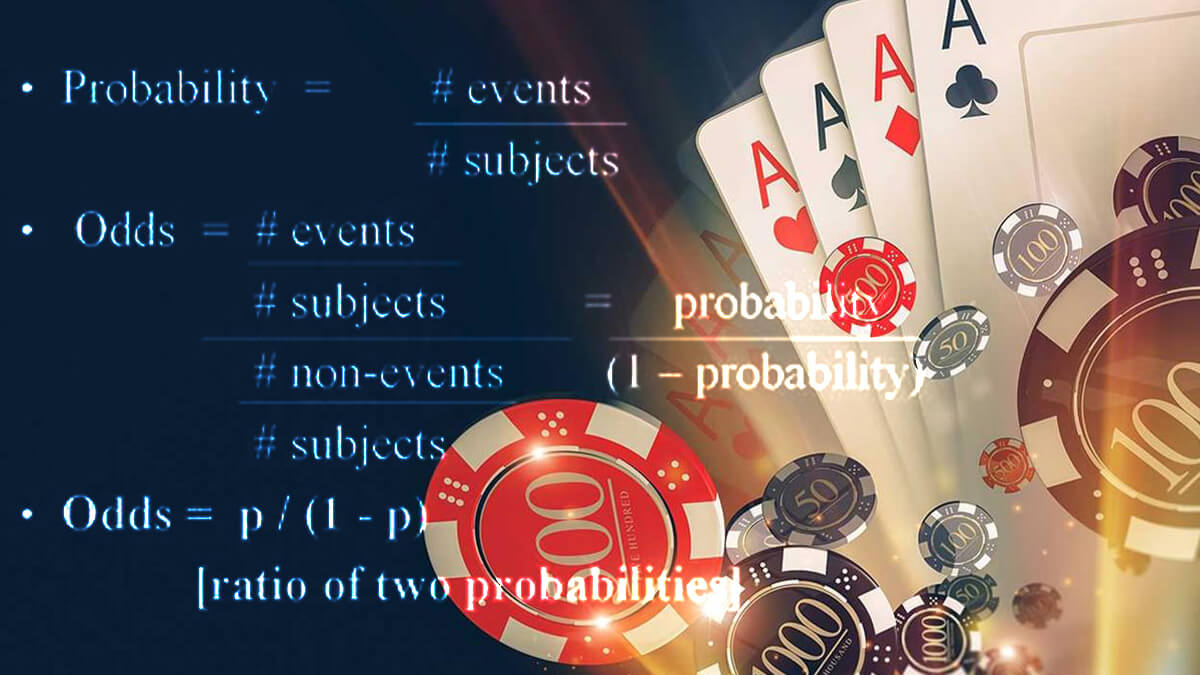Most of what the casino gambler needs to understand about most casino games comes down to an exercise in probability.
The word probability has 2 meanings:
- The likelihood that something will or won’t happen.
- The branch of math that studies likelihoods.
And like most branches of math, there are specific rules that you need to understand to understand probability.
In this post, I cover the basics of probability in a succinct, easy-to-understand way:
We’re Trying to Ascertain the Likelihood of an “Event”
Anything that can happen is an event. If you’re trying to predict the probability of something happening, you’re said to be predicting the probability of that “event.”
For Instance:
- You might want to know the probability of a tossed coin landing on heads. It’s 50%, and most people know this already. You might also want to know the probability of rolling a 7 on a pair of standard six-sided dice in craps. That probability is 16.67% even though it seems like more when you’re actually at the craps table.
Some events aren’t as easy to pin down, though. You might want to know the probability that it will rain tonight. The meteorologist says it’s 50%, but how often is the weatherman right in your city?
Yeah, mine too.
But One Thing About Every Event Is True:
Its probability is always a number between 0 and 1. An event with a probability of 0 will never happen, and an event with a probability of 1 will always happen.
Here’s an example:
- The probability of rolling a total of 13 in a game of craps is 0. The highest total you can roll is 12. Also, the probability of rolling a whole number between and including 2 and 12 is 1.
Finally, there’s no such thing as a negative probability – since an event with a probability of 0 can never happen, having a number lower than 0 would be meaningless.
The Probability of an Event Happening + the Probability It Won’t Happen Is Always 0
Basically, you’re just looking at the probability of all the possible outcomes. How could you come up with an outcome other than 1?
After all, when you’re talking about events, something’s going to happen – it’s either the event you’re solving the probability problem for, or it’s something other than that event.
Let’s say you’re rolling a single six-sided die, and you know that the probability of rolling a 6 is 1/6. You can infer from this that the probability of NOT rolling a 6 is 5/6.
How do you calculate this?
If x is the probability that you won’t roll a 6, you wind up with the following formula: X + 1/6 = 1
Which implies the following: 1/6 = 1 – x
And here you thought you’d never get to use algebra in real life.
For Multiple Events, Use the Product of Independent Events
It’s easy to see what the probability of rolling a 6 on a six-sided die.
But what if you wanted to know the probability of rolling a 6 twice in a row? Or 3 times in a row? Since it’s the product, you would multiple 1/6 X 1/6, and you’d get the probability of rolling a 6 twice in a row: 1/36.
This assumes, of course, that these are independent events. When you roll a six-sided die, what happened on the previous rolls doesn’t change the number of outcomes or the likelihood of each outcome.
What’s an example of a probability problem where the events AREN’T independent? Blackjack is the classic example, and card counters use this to their advantage. That’s because every time you deal a card, unless you shuffle that card back into the deck, you’ve eliminated the possibility of getting that card again.
Here’s an Example:
With a fresh deck of cards, you have a 13/52, or 1/4, probability of drawing a club. But say you’ve drawn a card, and it was a club. What’s the probability that you’ll draw a club on the next card?
There are only 12 clubs left in the deck, and there are only 51 cards total left in the deck, which means the probability has changed to 12/51.
It’s easier to compare these probabilities as percentages, probably: 1/4, obviously, is 25%. 12/51 requires some division, but it amounts to 23.5%.
That’s close, but it’s still statistically significant and lower.
“Odds” Are Just Another Way to Express These Probabilities
The probability of an event is just a comparison of the number of ways an event can occur compared to the total possible outcomes.
Odds, on the other hand, compares the number of ways an event can happen with how many ways it can happen. It’s a subtle but important difference.
Here’s an example:
- The probability of drawing a club from a standard deck of cards is 1/4, or 25%. The ODDS of drawing a club from a standard deck of cards are 3 to 1. For every club in the deck, there are 3 other cards which aren’t clubs. This becomes important when you start comparing the odds of an event happening and the payout odds for a bet.
They’re not always the same.
If they were, you’d have no professional poker players, and the casinos wouldn’t be so profitable.
A Classic Probability Example Using a Venerable Casino Game
One of the most popular table games in the casino is roulette. And one of the most popular bets on the roulette wheel is the single-number bet.
What are the odds of winning the single-number bet in roulette? You have 38 numbers on a roulette wheel. If you bet on one of those numbers, you have 37 possible ways to lose. The odds of winning are 37 to 1.
How much does the bet pay out? 35 to 1 What does this mean for the gambler?
In the long run, it means that it’s statistically impossible to win at roulette in the long run. Sure, you can win in the short term because roulette is a random game of independent events. In the long run, though, you’ll lose 37 times for every time you win. And when you win, you’ll win 35 times your wager.
Do you see how the casino makes its money in that situation?
When you average that loss into the total number of wagers, you get the house edge, which I cover next.
The House Edge
The difference between the payout odds and the true odds on a bet is the house edge.
It’s a statistical average of how much an average gambler can expect to lose over time when betting on a specific casino bet. If you bet $100 on 38 spins of the roulette wheel, you’ll lose $3700 on the 37 losing spins.
You’ll win $3500 on your winning spin. The difference is $200, which the casino gets. Average that $200 by 38 spins, and you’ve lost $5.26 per spin. And since I used $100 bets in my example, the percentage of each bet that you’ve lost is obviously 5.26%.
You could calculate the house edge by using $5 bets or $20 bets, but using $100 bets makes it easier to convert to a percentage. The important thing to understand about the house edge is that it’s a long-term phenomenon that’s as powerful as compound interest. But in the short run, it has no meaning.
It’s impossible to lose $5.26 on a single $100 roulette bet. You either win $3500 or lose $100.
In fact, it’s hard to see results that look like the statistical prediction until you start getting into 1000s of trials. Hundreds of trials just aren’t enough.
This phenomenon has to do with 2 things:
- Variance
- The Law of Large Numbers
Variance is just what we call it when random things happen in the short term that don’t happen according to what the probabilities say they “should.”
The Law of Large Numbers just says that the closer you get to an infinite number of trials, the closer your actual results get to the statistical prediction.
Most gamblers get distracted by variance, and that’s what keeps the casinos in business.
Casinos and Professional Gamblers Deal With Long Term Probabilities
If you think about the implications behind variance and the Law of Large Numbers, it should become obvious how casinos and professional gamblers make their money.
They operate in the long run, while recreational gamblers operate in the short run.
Casinos are able to get into the land of large numbers faster than any individual gambler ever could. That’s because they have a customer base. If you’re playing roulette, you might be making 35 bets per hour. That means you’re going to see short term results that don’t mirror what the probabilities suggest for a long time. Depending on how often you visit the casino, it might be years.
But suppose you’re the casino, and you have 8 roulette tables with an average of 8 players per table. The casino is seeing 8 players make 35 bets per hour at 8 tables, 24 hours a day. That’s 8 X 8 X 35 X 24, or 53,000+ spins per day. When you’re dealing with over 50,000 bets a day, you’re going to see results close to the statistical average. And the individuals who occasionally win a few hundred dollars or even a couple of grand just don’t matter.
The other gamblers at the table paid for their winnings, anyway.
Conclusion
Probability and odds are critical if you want to really understand what’s going on at the casino. Luckily, it’s mostly just simple math combined with level-headed perspective.
Most of what you need to know was covered in this post and can be extrapolated to apply to any gambling situation.
Michael Stevens
Michael Stevens has been researching and writing topics involving the gambling industry for well over a decade now and is considered an expert on all things casino and sports betting. Michael has been writing for GamblingSites.org since early 2016. …



